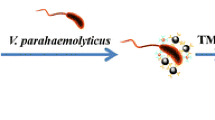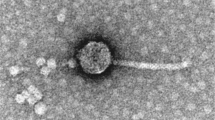Abstract
Vibrio parahaemolyticus (V. parahaemolyticus) is one of the most common and widely distributed food-borne bacteria. Thus, it is necessary to establish a rapid, specific, and sensitive detection approach for V. parahaemolyticus. The strategy of combining immunomagnetic separation method (IMS) and polymerase chain reaction (PCR) measure was established successfully for V. parahaemolyticus detection, because ordinary IMS always has restriction on employing conventional antibodies for their labor-intensive procedure, batch-to-batch variation in functionality, and limited shelf-life. Herein, we have generated a novel phage display-derived peptide with an amino acid sequence of MPRLPPA and use it as bio-recognition probe in IMS. The peptide was evaluated to have the advantages of high specificity, sensitivity, easy reproduction, and well-defined ability. When compared with the rabbit polyclone IgG antibodies (IgG)-IMS and chicken egg yolk antibodies (IgY)-IMS, peptide-IMS has absolute superiorities in terms of the dosages, detection time, and capture efficiency. It has the ability to take the place of traditional antibody and unquestionable value of reusing. Furthermore, the detection system of peptide-IMS-PCR possessed high specificity with a limit of detection (LOD) of 102 CFU/mL in pure culture and 103 CFU/mL in oyster. Thus, we successfully synthesize peptide against V. parahaemolyticus and applied it to establish a sensitive and specific detecting method for V. parahaemolyticus.




Similar content being viewed by others
References
Agrawal S, Kulabhusan PK, Joshi M, Bodas D, Paknikar KM (2016) A high affinity phage-displayed peptide as a recognition probe for the detection of Salmonella Typhimurium. J Biotechnol 231(10):40–45. https://doi.org/10.1016/j.jbiotec.2016.05.027
Anuj T, Saravanan V, Karunasagar I, Karunasagar I (2008) Detection of Vibrio parahaemolyticus in tropical shellfish by SYBR green real-time PCR and evaluation of three enrichment media. Int J Food Microbiol 129(2):124–130. https://doi.org/10.1016/j.ijfoodmicro.2008.11.006
Banerjee SK, Farber JM (2017) Detection, enumeration, and isolation of Vibrio parahaemolyticus and V. vulnificus from seafood: development of a multidisciplinary protocol. J AOAC Int 100(2):445–453. https://doi.org/10.5740/jaoacint.16-0290
Bochao H, Xiaodong Y, Erpeng G, Peizhan Z, Ding X, Qi Z, Li DN (2019) The preparation and antibacterial effect of egg yolk immunoglobulin (IgY) against the outer membrane proteins of Vibrio parahaemolyticus. J Sci Food Agric 99(5):2565–2571. https://doi.org/10.1002/jsfa.9470
Cheng K, Pan D, Jun T, Li Y, Yingwang Y, Feng X (2016) Colorimetric integrated PCR protocol for rapid detection of Vibrio parahaemolyticus. Sensors 16(10):1600. https://doi.org/10.3390/s16101600
Clark KD, Purslow JA, Stephen A (2017) Rapid preconcentration of viable bacteria using magnetic ionic liquids for PCR amplification and culture-based diagnostics. J Anal Bioanal Chem 409(21):4983–4991. https://doi.org/10.1007/s00216-017-0439-y
Dalmasso A, Neve FL, Suffredini E (2009) Development of a PCR assay targeting the rpoA gene for the screening of Vibrio genus. J Food Anal Methods 2(4):317–324. https://doi.org/10.1007/s12161-009-9089-9
Datta S, Janes ME, Simonson JG (2008) Immunomagnetic separation and coagglutination of Vibrio parahaemolyticus with anti-flagellar protein monoclonal antibody. J Clin Vaccine Immunol 15(10):1541–1546. https://doi.org/10.1128/cvi.00141-08
Duan N, Shen M, Wu S, Zhao C, Wang Z (2017) Graphene oxide wrapped Fe3O4@Au nanostructures as substrates for aptamer-based detection of Vibrio parahaemolyticus by surface-enhanced Raman spectroscopy. Microchim Acta 184:2653–2660. https://doi.org/10.1007/s00604-017-2298-9
Foddai ACG, Grant IR (2017) Sensitive and specific detection of viable Mycobacterium avium subsp. paratuberculosis in raw milk by the peptide-mediated magnetic separation-phage assay. J Appl Microbiol 122(5):1357–1367. https://doi.org/10.1111/jam.13425
Garret FF, Freitag R (2000) Use of the avidin (imino) biotin system as a general approach to affinity precipitation. Biotechnol Bioeng 71(3):223–234. https://doi.org/10.1385/1-59745-579-2:35
Garrido A, Chapela M-J, Ferreira M, Atanassova M, Fajardo P, Lago J, Vieites JM, Cabado AG (2012) Development of a multiplex real-time PCR method for pathogenic Vibrio parahaemolyticus detection (tdhþ and trhþ). Food Control 24(1–2):128–135. https://doi.org/10.1016/j.foodcont.2011.09.015
González Martı́n, Argaraña CE, Fidelio GD (1999) Extremely high thermal stability of streptavidin and avidin upon biotin binding. Biomol Eng 16(1–4):67–72. https://doi.org/10.1016/s1050-3862(99)00041-8
Hayat A, Barthelmebs L, Marty JL (2011) Enzyme-linked immunosensor based on super paramagnetic nanobeads for easy and rapid detection of okadaic acid. J Anal Chim Acta 690(2):248–252. https://doi.org/10.1016/j.aca.2011.02.031
Josefsen MH, Krause M, Hansen F (2007) Optimization of a 12-hour TaqMan PCR-based method for detection of Salmonella bacteria in meat. Applied and Environmental Microbiology, 2007 73(9):3040–3048. https://doi.org/10.1128/aem.02823-06
Kwok AY, Wilson JT, Coulthart M (2002) Phylogenetic study and identification of human pathogenic Vibrio species based on partial hsp60 gene sequences. J Can J Microbiol 48(10):903–910. https://doi.org/10.1139/w02-089
Lim JM, Heo NS, Seo Yeong O (2018) Selection of affinity peptides for interference-free detection of cholera toxin. J Biosensors Bioelectron 99:289–295. https://doi.org/10.1016/j.bios.2017.07.075
Liu Y, Zhao C, Kaiyue F (2017) Selective turn-on fluorescence detection of Vibrio parahaemolyticus in food based on charge-transfer between CdSe/ZnS quantum dots and gold nanoparticles. J Food Control 80:380–387. https://doi.org/10.1016/j.foodcont.2017.05.032
Lozano-Leon A, Torres J, Osorio CR (2003) Identification of tdh-positive Vibrio parahaemolyticus from an outbreak associated with raw oyster consumption in Spain. J FEMS Microbiol Lett 226(2):281–284. https://doi.org/10.1016/s0378-1097(03)00604-9
Morton J, Karoonuthaisiri N, Stewart LD (2013) Production and evaluation of the utility of novel phage display-derived peptide ligands to Salmonella spp. for magnetic separation. J Appl Microbiol 115(1):271–281. https://doi.org/10.1111/jam.12207
Nhung PH, Ohkusu K, Miyasaka J (2007) Rapid and specific identification of 5 human pathogenic Vibrio species by multiplex polymerase chain reaction targeted to dnaJ gene. J Diagn Microbiol Infect Dis 59(3):271–275. https://doi.org/10.1016/j.diagmicrobio.2007.05.016
O’Brien LM, Stewart LD, Strain SAJ, Grant IR (2016a) Novel monoclonal antibody and peptide binders for Mycobacterium avium subsp. paratuberculosis and their application for magnetic separation. PLoS ONE 11(1):e0147870. https://doi.org/10.1371/journal.pone.0147870
O’Brien LM, Stewart LD, Strain SA (2016b) Novel monoclonal antibody and peptide binders for Mycobacterium avium subsp. paratuberculosis and their application for magnetic separation. PLoS One 11(1):e0147870. https://doi.org/10.1371/journal.pone.0147870
Padmanaban G, Park H, Choi JS (2014) Identification of peptides that selectively bind to myoglobin by biopanning of phage displayed-peptide library. J Biotechnol 187:43–50. https://doi.org/10.1016/j.jbiotec.2014.07.435
Philippova O, Barabanova A, Molchanov V (2011) Magnetic polymer beads: recent trends and developments in synthetic design and applications. J Eur Polym J 47(4):542–559. https://doi.org/10.1016/j.eurpolymj.2010.11.006
Raghunath P, Acharya S, Bhanumathi A (2008) Detection and molecular characterization of Vibrio parahaemolyticus isolated from seafood harvested along the southwest coast of India. J Food Microbiol 25(6):824–830. https://doi.org/10.1016/j.fm.2008.04.002
Rodi DJ, Lee M, Kay BK (2002) One from column A and two from column B: the benefits of phage display in molecular-recognition studies. Curr Opin Chem Biol 6(1):92–96. https://doi.org/10.1016/s1367-5931(01)00287-3
Román M, Carlos OL, Lina AZ, Eugenio G, Ne J, César SC, Sergio F (2019) Evaluation of a cocktail of phages for the control of presumptive Vibrio parahaemolyticus strains associated to acute hepatopancreatic necrosis disease. Aquac Res 50(11):3107–3116. https://doi.org/10.1111/are.14258
Sakata J, Kawatsu K, Iwasaki T (2015) Development of a rapid and simple immunochromatographic assay to identify Vibrio parahaemolyticus. J Microbiol Methods 116:23–29. https://doi.org/10.1016/j.mimet.2015.06.009
Sharma A, Saha A, Bhattacharjee S (2006) Specific and randomly derived immunoactive peptide mimotopes of mycobacterial antigens. J Clin Vaccine Immunol 13(10):1143–1154. https://doi.org/10.1128/cvi.00127-06
Sidhu SS, Fairbrother WJ, Deshayes K (2003) Exploring protein–protein interactions with phage display. Chembiochem 4(1):14–25. https://doi.org/10.1002/chin.200310279
Smith JE, Sapsford KE, Tan W (2011) Optimization of antibodyconjugated magnetic nanoparticles for target preconcentration and immunoassays. J Anal Biochem 410(1):124–132. https://doi.org/10.1016/j.ab.2010.11.005
Teh CS, Chua KH, Thong KL (2010) Simultaneous differential detection of human pathogenic and nonpathogenic Vibrio species using a multiplex PCR based on gyr B and pnt A genes. J Appl Microbiol 108(6):1940–1945. https://doi.org/10.1111/j.1365-2672.2009.04599.x
Teng J, Ye Y, Yao L (2017) Rolling circle amplification based amperometric aptamer/immuno hybrid biosensor for ultrasensitive detection of Vibrio parahaemolyticus. J Microchim Acta 184(9):3477–3485. https://doi.org/10.1007/s00604-017-2383-0
Thompson FL, Iida T, Swings JG (2004) Biodiversity of Vibrios. J Microbiol Mol Biol Rev 68(3):403–431. https://doi.org/10.1128/mmbr.68.3.403-431.2004
Ulises HC, Tatiana G, Karlen G (2009) Peptide sequences identified by phage display are immunodominant functional motifs of pet and pic serine proteases secreted by Escherichia coli and Shigella flexneri. J Peptides 30(12):2127–2135. https://doi.org/10.1016/j.peptides.2009.09.019
Ulrichs T, Lefmann M, Reich M (2005) Modified immunohistological staining allows detection of Ziehl-Neelsen-negative Mycobacterium tuberculosis organisms and their precise localization in human tissue. J Pathol 205(5):633–640. https://doi.org/10.1002/path.1728
Wen C, Jiang Y, Li X (2017a) Efficient enrichment and analyses of bacteria at ultralow concentration with quick-response magnetic nanospheres. J ACS Appl Mater Interfaces 9(11):9416–9425. https://doi.org/10.1021/acsami.6b16831
Wen CY, Jiang YZ, Li XY, Tang M, Wu LL, Hu J, Pang DW, Zeng JB (2017b) Efficient enrichment and analyses of bacteria at ultralow concentration with quick-response magnetic nanospheres. ACS Appl Mater Interfaces 9(11):9416–9425. https://doi.org/10.1021/acsami.6b16831
Wu S, Wang Y, Duan N, Ma H, Wang Z (2015) Colorimetric aptasensor based on enzyme for the detection of Vibrio parahemolyticus. J Agric Food Chem 63(35):7849–7854. https://doi.org/10.1021/acs.jafc.5b03224
Xiong J, Wang W, Zhifeng F (2017) Fluorimetric sandwich affinity assay for Staphylococcus aureus, based on dual-peptide recognition on magnetic nanoparticles. Microchim Acta 184(10):4197–4202. https://doi.org/10.1007/s00604-017-2396-8
Xu D, Ji L, Wu X, Yan W, Chen L (2018) Detection and differentiation of Vibrio parahaemolyticus by multiplexed real-time PCR. Can J Microbiol 64(11):809–815. https://doi.org/10.1139/cjm-2018-0083
Yang H, Qin L, Wang Y (2015) Detection of Mycobacterium tuberculosis based on H37Rv binding peptides using surface functionalized magnetic microspheres coupled with quantum dots–a nano detection method for Mycobacterium tuberculosis. J Int Nanomed 10:77–88. https://doi.org/10.2147/ijn.s71700
Zeng J, Wei H, Zhang L, Liu X, Zhang H, Cheng J, Ma D, Zhang X, Fu P, Liu L (2014) Rapid detection of Vibrio parahaemolyticus in raw oysters using immunomagnetic separation combined with loop-mediated isothermal amplification. Int J Food Microbiol 174:123–128. https://doi.org/10.1016/j.ijfoodmicro.2014.01.004
Zhang ZH, Xiao LL, Lou Y (2015) Development of a multiplex real-time PCR method for simultaneous detection of Vibrio parahaemolyticus, Listeria monocytogenes and Salmonella spp in raw shrimp. J Food Control 51:31–36. https://doi.org/10.1016/j.foodcont.2014.11.007
Zhu RG, Li TP, Jia YF (2012) Quantitative study of viable Vibrio parahaemolyticus cells in raw seafood using propidium monoazide in combination with quantitative PCR. J Microbiol Methods 90(3):262–266. https://doi.org/10.1016/j.mimet.2012.05.019
Funding
This study was funded by the National Natural Science Foundation of China (Grant number 81502849, 81872668), the Scientific and Technological Research Project of Jilin Province (Grant numbers 20170204003SF and 20180101095JC), Health commission of Jilin Province (Grant number 2019Q011), the Bethune Medical Scientific Research Fund Project of Jilin University (Grant number 2018B20), and the Fundamental Research Funds for the Central Universities.
Author information
Authors and Affiliations
Corresponding authors
Ethics declarations
Conflict of Interest
Yue Zhai declares that he has no conflict of interest. Chao Zhao declares that he has no conflict of interest. Li Li declares that he has no conflict of interest. Kun Xu declares that he has no conflict of interest. Juan Wang declares that he has no conflict of interest. Xiuling Song declares that he has no conflict of interest. Hui Li declares that he has no conflict of interest.
Ethical Approval
This article does not contain any studies with human participants or animals performed by any of the authors.
Informed Consent
Not applicable.
Additional information
Publisher’s Note
Springer Nature remains neutral with regard to jurisdictional claims in published maps and institutional affiliations.
Rights and permissions
About this article
Cite this article
Zhai, Y., Zhao, C., Li, L. et al. Production of Phage Display-Derived Peptide and the Application for Detecting Vibrio parahaemolyticus by Combined PCR Technology. Food Anal. Methods 13, 1906–1917 (2020). https://doi.org/10.1007/s12161-020-01800-9
Received:
Accepted:
Published:
Issue Date:
DOI: https://doi.org/10.1007/s12161-020-01800-9




